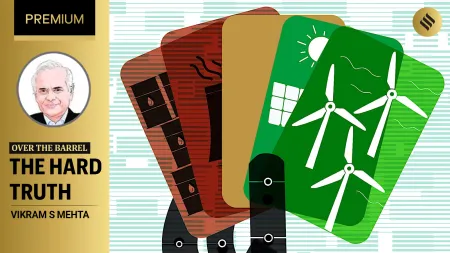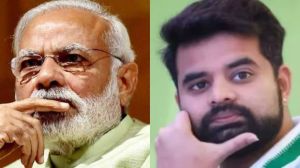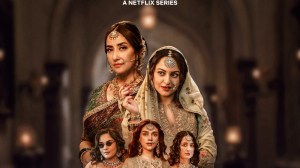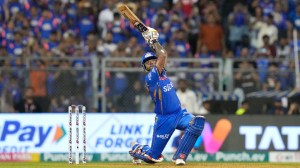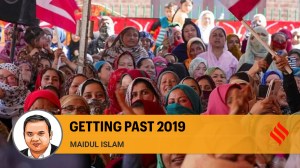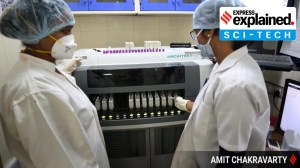- India
- International
Nine state stops on road to Lok Sabha 2024
2023 is packed with state elections that could shape the political script of 2024. The popularity of Modi and BJP will be tested as he nears the end of his second term. Rahul will hope to walk further on the road to Congress revival. Kejriwal will try to go from being a successful disruptor to a claimant for bigger prizes.
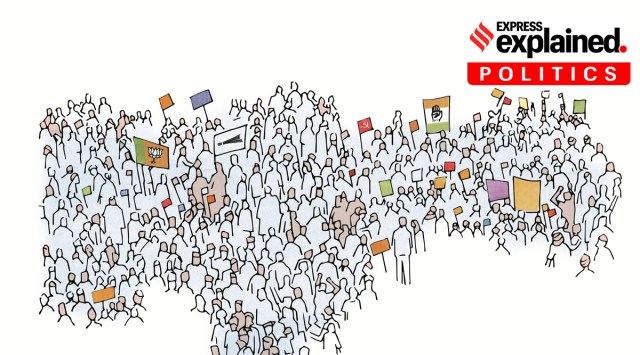 The BJP will try to present the G20 summit as evidence of India’s growing global stature under Modi’s leadership. The government’s ongoing tussle with the Supreme Court could intensify further next year. (Illustration: Mithun Chakraborty)
The BJP will try to present the G20 summit as evidence of India’s growing global stature under Modi’s leadership. The government’s ongoing tussle with the Supreme Court could intensify further next year. (Illustration: Mithun Chakraborty) With a mix of fear and hope, India came out of the long shadow of Covid in 2022 and life and politics — the latter more turbulent and fractious than at any time in recent history — started to return to normal. 2022 saw ideological divisions worsen, social and communal cleavages deepen, and the political chasm between the BJP and the opposition widen.
The BJP maintained its electoral dominance, winning five of the seven state elections including Uttar Pradesh, but the defeat in Himachal Pradesh at the end of the year came as a reality check. Prime Minister Narendra Modi continued to occupy the political centrestage, and his popularity, at least electorally, remained more or less intact.
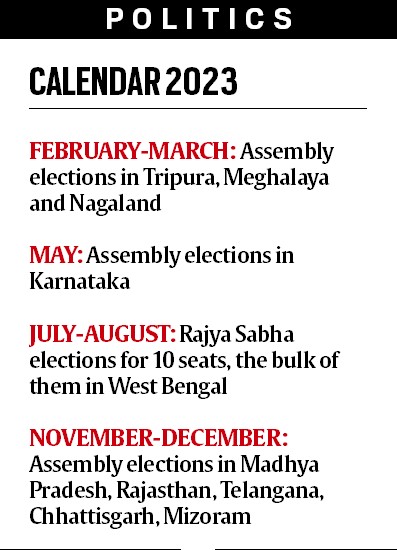
The Congress finally addressed its leadership question by choosing Mallikarjun Kharge. Former president Rahul Gandhi’s ambitious march from Kanyakumari to Kashmir got him significant mileage but his party’s electoral woes continued. The Himachal victory brought hope, but it was decimated in Punjab and Gujarat.
Fleet-footed parties like the Aam Aadmi Party (AAP) and Trinamool Congress (TMC) are posing a challenge to the grand old party in newer territories. The AAP emphatically declared its arrival in 2022, knocking down the Congress in Punjab and registering its presence in Goa and Gujarat.
The bitterness in politics, both in Parliament and outside, worsened. Conversations in social media and elsewhere took on clearer communal overtones. In litigation around the Gyanvapi mosque-Kashi Vishwanath Temple dispute, in the gruesome beheading in Udaipur and the grisly murder of Shraddha Walkar, and in the nonsensical controversy over a Shah Rukh Khan-Deepika Padukone song, the communal cauldron was kept simmering.
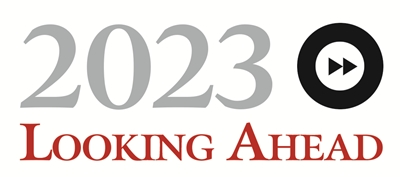

The government sought to hardsell India’s G20 presidency even as the economic recovery remained tentative with the Russia-Ukraine war pushing up food and energy prices. To address the jobs crisis, it rolled out the Agnipath scheme despite massive street protests, it clashed with the higher judiciary, and it tried to turn the Chinese aggression at the LAC into a political attack on the opposition.
The political calendar of 2023 is packed with high-stakes state elections. Political events of 2023 are important because they have the potential to shape the debate and narrative for the Lok Sabha battle of 2024.
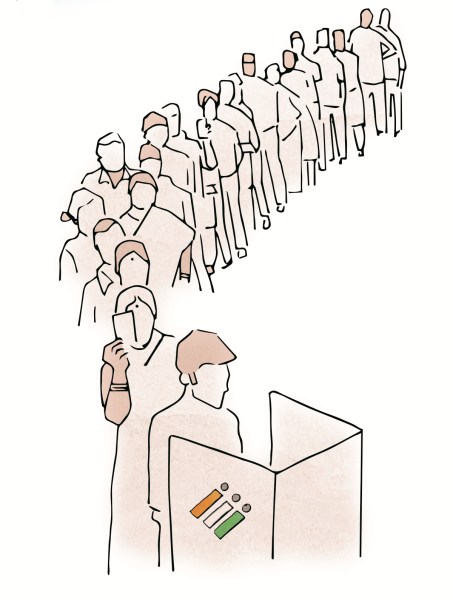 Illustration: Mithun Chakraborty
Illustration: Mithun Chakraborty
The semi-final clash
2023, in all likelihood, will shape the political script of 2024.
The BJP and Congress will be in election mode throughout the year. From Tripura, Meghalaya, and Nagaland in February-March, Karnataka in May, and Madhya Pradesh, Rajasthan, Chhattisgarh, Mizoram, and Telangana in November-December, they will clash in state elections around the country — the outcomes of which will give a sense of the way the political wind is blowing.
The ruling party won Gujarat, UP, Uttarakhand, Goa, and Manipur in 2022, but it will not rest on its laurels. The nine states that will go to polls next year account for 116 Lok Sabha seats. Some of them have voted differently in the previous Lok Sabha and Assembly elections. In 2018, the BJP lost in Rajasthan, Madhya Pradesh, and Chhattisgarh, but decimated the Congress in Lok Sabha elections a year later.
The ruling party is not in great shape in Karnataka; the situation of the Congress is no different in Rajasthan. Madhya Pradesh and Chhattisgarh could spring surprises. In Telangana, the BJP will use its full might and organisational firepower to try to dislodge K Chandrashekar Rao’s Telangana Rashtra Samithi (TRS) — now rechristened Bharat Rashtra Samithi (BRS) — and take a second South Indian state.
It will also be a crucial year for the TMC, which is keen to extend its political presence outside West Bengal. The AAP’s massive success in Punjab and its small but significant openings in Goa (2 seats) and Gujarat (5 seats) would have made the TMC both anxious and hopeful. Mamata Banerjee’s party is working hard to make inroads in Tripura and Meghalaya.
What next for BJP and Govt
The BJP believes that Modi’s personal popularity and connect with voters remain largely intact. While caste, community, and regional equations play a key role in state elections and campaigns are often centered around local issues, the ruling party has always banked on Modi’s carefully crafted charisma and appeal. This strategy will be put to test again in 2023.
Every decision and policy announcement of the Modi government next year will be viewed and analysed from the point of view of the Lok Sabha election. The first glimpse of the government’s political strategy could come in the Union Budget, the last full budget before the 2024 elections. The recovery has been slow, inflation has soared, and the global economic situation remains uncertain.
Will the government resort to a slew of big-bang populist promises and measures? How will it strike a balance among fiscal prudence, economic growth, and electoral imperatives?
Another key question: Will the Modi cabinet don a new look next year? The timing and scale of the reshuffle — if it happens — will be interesting.
Much of the government’s attention will be on the G20 summit in September. It has managed to create a hype around India’s presidency, and the build-up to the summit is key to its plan to position the event as an occasion for national rejoicing, and to use it to proclaim India’s growing stature under Modi.
Will Assembly elections be held in Jammu and Kashmir in the summer? The government will be keen to hold transparent elections in J&K ahead of the summit to send out a message to the world.
The second half of the year will see the build-up to the inauguration of the Ram Temple in Ayodhya. The trust overseeing the construction has signalled that celebrations for opening the mandir will start in December, in time for the Lok Sabha election.
Congress: Revive or perish
This year saw the Congress unveil two experiments that broke from its recent history. The Gandhis made way for a person outside the first family to become party president, and Rahul Gandhi embarked on his arduous Yatra with the hope of turning around both his party’s fortunes and his own image.
After a four-year electoral drought, the Congress tasted success in a state election (Himachal) but it was humiliated in Punjab and Gujarat. The impact of the Yatra, if any, and the effect of the separation of powers will be visible next year. Rahul’s walkathon has helped dilute the perception that he is a non-serious leader. But it is too early to rush to predictions that have been made — and proven wrong — earlier.
Kharge has shown signs of emerging as a potent speaker who could take on the BJP. It is to be seen whether he can bring at least some opposition parties together in a credible coalition.
Of the election-bound states next year, two are ruled by the Congress. The party will have to win some and retain some if it is to pose a credible challenge to the Modi juggernaut in 2024. It fancies its chances in Karnataka and Madhya Pradesh, and believes it is on a stronger wicket in Chhattisgarh. However, it also has a recent history of snatching defeat from the jaws of victory.
While the G23, which functioned as a pressure group within the party, has lost its relevance, the big organisational question is whether Kharge and the leadership would agree to hold elections to the Working Committee at the AICC plenary in Raipur in February. The biggest challenge for the Congress — and the opposition as a whole — will be to navigate the politics of polarisation which will likely get worse in the election year.
AAP, regional forces, Opp unity
2022 was a defining year for AAP — it became the third party to be in power in more than one state, and it’ll become the ninth national party. The big question is whether Arvind Kejriwal will try his brand of ideology-agnostic politics in states going to polls next year.
Kejriwal has to maintain the tempo if he has to emerge as a challenger to the BJP in 2024. And he has competition. The TMC and BRS have national ambitions, and Nitish Kumar has declared that the 2025 Bihar elections will be fought under Tejashwi Yadav’s leadership, suggesting that he senses an opportunity for himself in national politics. It is significant that almost all non-Congress, non-BJP Prime Ministers have come from the Janata family.
What is Kejriwal’s next big idea? Many in the opposition believe his brand of politics more or less mirrors that of the BJP. And that makes him persona non grata for many parties. As the AAP, TMC, and BRS eye national roles, the casualty will be opposition unity.
Is a pan Indian anti-BJP electoral coalition possible? Many parties prefer state-level alliances, though some are pushing for a non-BJP, non-Congress coalition — a sort of third front. Posturing and discussions in that direction will continue in the opposition space.
Government-judiciary conflict
The last months of this year saw the government and the Supreme Court enter into confrontation mode once again. After remaining silent for seven years, the government has started to express unhappiness over the scuttling of the National Judicial Appointments Commission Act by the apex court in 2015.
The Supreme Court has pushed back against the government’s criticism of the collegium system. There is a tussle over names being recommended by the Supreme Court collegium for appointment as judges, with the government delaying appointments.
The opposition feels the government is keeping the threat of bringing back the NJAC alive to get the judiciary to fall in line. The tussle could worsen next year, as the court hears petitions and delivers judgments on matters with major political implications. Among them: appointment of members of the Election Commission, challenges to demonetisation and constitutional changes in J&K, electoral bonds, the Citizenship Amendment Act.
Also Read in Gujarati: Click Here
More Explained
EXPRESS OPINION
May 07: Latest News
- 01
- 02
- 03
- 04
- 05





